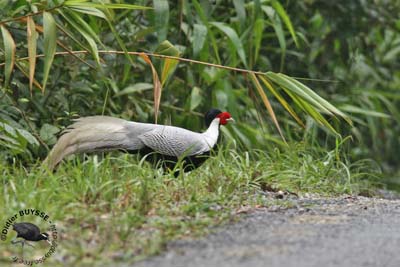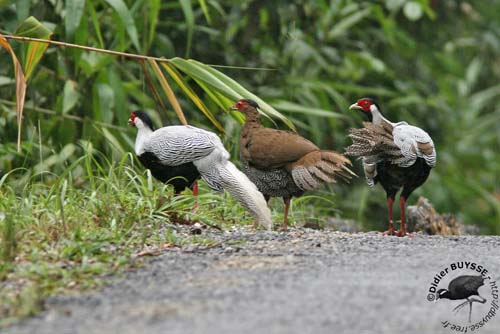
Silver Pheasant
Lophura nycthemera
Galliforme Order – Phasianidae Family
BIOMETRICS:
Length: M: 120-125 cm with 60-65 cm for the tail
F: 70-71 cm with 24-32 cm for the tail
Weight: M: 1130-2000 g – F: 1150-1300g
DESCRIPTION:
Silver Pheasant has 15 subspecies sharing the range.
The nominate race Lophura nycthemera (here described and displayed) is the largest and the whitest of all races.
Adult male has white upperparts and tail, finely streaked black.
Underparts are blue-black.
The neck is pure white above and blue-black below.
On the head, the bare face and the wattles are bright scarlet. Male has long blue-black crest on the rear crown, which elongated feathers extending to the rear neck.
The strong bill is whitish. Eyes are reddish-brown. Legs and feet are red. Each leg shows one medium-sized spur.
Female has brown plumage on the upperparts. On the underparts, the brown feathers are broadly edged creamy-white. The uppertail is brown, whereas the undertail and outer rectrices are brown streaked creamy-white.
On the head, face is bright red but lacks the wattles. The blackish crest is shorter than in male. Legs and feet are pinkish.
Immature is brown as female, finely streaked black on the upperparts. The young male reaches the adult plumage in the second year.
PROTECTION / THREATS / STATUS:
Most of the races are safe and widely distributed. They are fairly common in suitable habitat.
But some isolated races such as annamensis, whiteheadi, engelbachi and lewisi are vulnerable and endangered. They suffer degradation and habitat loss.
Fr: Faisan argenté
All : Silberfasan
Esp : Faisán Plateado
Ital : Fagiano argentato
Nd : Zilverfazant
Russe : Серебристый фазан
Photographs by Didier Buysse
Vision d’Oiseaux
Text by Nicole Bouglouan
Sources:
HANDBOOK OF THE BIRDS OF THE WORLD Vol 2 by Josep del Hoyo-Andrew Elliot-Jordi Sargatal - Lynx Edicions - ISBN: 8487334156
L’ENCYCLOPEDIE MONDIALE DES OISEAUX - Dr Christopher M. Perrins - BORDAS - ISBN: 2040185607
Citation: Hennache, A. & Ottaviani, M. (2005). Monographie des faisans, volume 1. Edition W.P.A. France, Clères, France. ISBN: 2-9512467-1-4
Citation: Hennache, A. & Ottaviani, M. (2006). Monographie des faisans, volume 2. Edition W.P.A. France, Clères, France.ISBN: 2-9512467-2-2
"Les auteurs renoncent à leurs droits d'auteurs pour que la vente de cet ouvrage, publié par la World Pheasant Association, soit destinée à soutenir des projets de conservation."

From left to right:
Adult male
Adult female
Immature male
The subspecies differ in black markings above, and size of the tail.
Females are mostly brown above, and differ in the underparts which may be reddish-brown to dark brown, more or less streaked black.
VOICE: SOUNDS BY XENO-CANTO
During the “wing-whirring” display, the male utters some cackles “cak-crak-cak, cak-crak-cak”, and grunts.
It also utters loud whistles in territory defence.
The young male utters some high-pitched chirping.
HABITAT:
Silver Pheasant is a grassland species. It frequents various types of forested habitats up to 1000 metres of elevation. It is often seen in more open areas at forest edges, but rarely in dense forests.
RANGE:
Silver Pheasant occurs in south-east Asia and China.
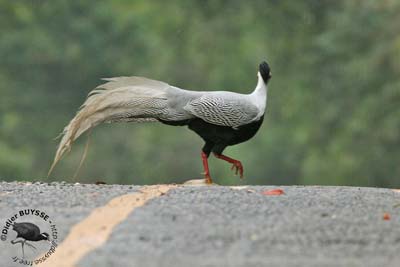
BEHAVIOUR:
Silver Pheasant feeds on plant matter such as seeds and fruits. It scratches the ground with the feet, and sometimes digs with the bill.
It also takes invertebrates according to the season. It usually feeds in the morning and the evening, before to reach the roost.
As most of grassland pheasants, the Silver Pheasant is polygamous. The dominant male may mates with several females. It defends the territory by giving loud whistles.
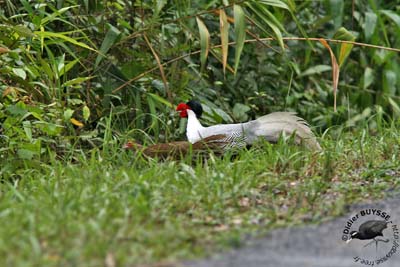
Typical courtship displays is the “wing-whirring”. The male is on the ground and performs fast wing beats, producing vibrations and whirring noises.
This display is the most important of the courtship.
It is also used as warning between males.
Female also performs wing-whirring, and in that case, this display would be used like contact call in order to gather all the members of the family group.
During the courtship displays, the head’s ornaments are very bright in colour, whereas outside the breeding season, they are duller and reduced.
FLIGHT:
Silver Pheasant is a terrestrial bird. It does not fly very often, but if disturbed, it takes off and reaches the protection of the cover.
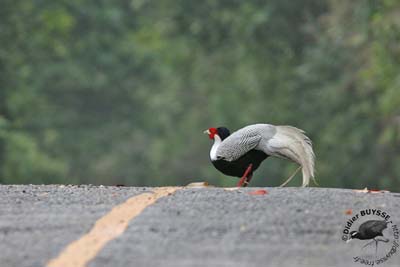
REPRODUCTION:
Breeding season may vary according to the range.
As most of Phasianidae, Silver Pheasant nests on the ground.
The clutch contains 6-9 eggs, sometimes up to 12, probably laid by more than one female.
The male is polygamous, and this species often breeds in small groups.
The chicks hatch during the wet season. In captivity, incubation lasts about 25-26 days. They are precocial and start to feed themselves very soon. Parents only have to guide them towards the food sources, and protect them against predators.
The chicks are covered in brown down very cryptic, providing them good camouflage outside of the nest.
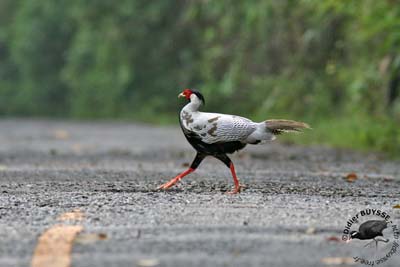
DIET:
Silver Pheasant feeds mainly on seeds and fruits, but it also consumes invertebrates.
